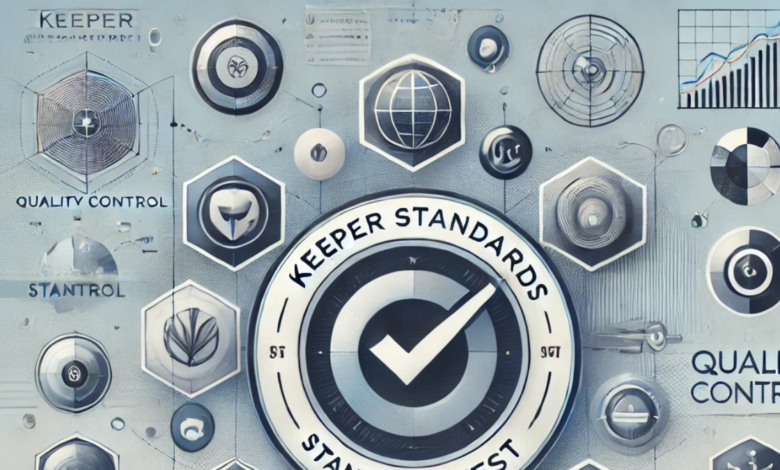Keeper Standards Test: A Comprehensive Guide

In the world of professional and personal development, the term “Keeper Standards Test” has emerged as a significant concept. This article will explore the Keeper Standards Test in-depth, covering its purpose, importance, implementation, and benefits.
Introduction to Keeper Standards Test
The Keeper Standards Test is not just another checklist or framework; it is a principle-centered approach designed to evaluate individuals, teams, or processes based on predefined criteria. This test ensures consistency, quality, and alignment with overarching goals or values.
- Defining the Keeper Standards Test
- At its core, the is a method used to gauge whether specific actions, behaviors, or results align with the desired standards. This test helps organizations and individuals maintain a high level of excellence by regularly assessing their alignment with established benchmarks.
- Why It Matters
- In today’s fast-paced world, where mediocrity can easily seep into everyday operations, the Standards Test acts as a guardrail. It ensures that everyone involved is adhering to the core values and quality metrics that drive success.
- Historical Context
- While the term may sound modern, the concept of testing standards has been around for centuries. From ancient civilizations ensuring the purity of their trade goods to modern corporations implementing quality control, the idea of a “standards test” has evolved into what we now recognize as the
Purpose of the Keeper Standards Test
The primary purpose of the Keeper Standards Test is to uphold excellence and consistency. But there’s more to it than meets the eye.
- Ensuring Accountability
- Accountability is a cornerstone of any successful endeavor. The helps individuals and teams take ownership of their responsibilities by regularly assessing their performance against clear, measurable standards.
- Driving Improvement
- This test is not just about identifying weaknesses; it’s about fostering growth. By highlighting areas of improvement, it encourages continuous development and learning.
- Building Trust
- In environments where standards are consistently upheld, trust flourishes. Whether in a workplace, educational setting, or personal project, the t reinforces reliability and integrity.
Core Components of the Keeper Standards Test
Understanding the Keeper Standards Test requires diving into its core components. Each element plays a critical role in ensuring the test’s effectiveness.
- Predefined Standards
- Every test begins with a clear definition of standards. These could be related to performance, quality, behavior, or outcomes. Without a well-defined benchmark, it’s impossible to measure success accurately.
- Evaluation Metrics
- Metrics are essential to quantify results. For example, in a workplace scenario, metrics could include deadlines met, quality scores, or customer satisfaction rates.
- Regular Assessments
- Consistency is key. The is not a one-time activity but a continuous process that ensures ongoing alignment with goals.
How to Implement the Keeper Standards Test
The might seem complex, but with a step-by-step approach, its implementation can be straightforward and effective.
- Define Clear Objectives
- Begin by understanding the “why” behind the test. What do you aim to achieve? Whether it’s improving team performance or ensuring product quality, clarity is crucial.
- Engage Stakeholders
- Everyone involved should understand the importance of the test. Open communication and collaboration are essential to get buy-in from all parties.
- Design the Framework
- Develop a framework that includes standards, evaluation criteria, and timelines. Make sure it’s adaptable to changing circumstances.
- Run the Test
- Conduct assessments based on the established framework. Collect data, analyze results, and identify gaps.
- Provide Feedback
- Feedback is a critical step. Share insights with stakeholders and create action plans to address identified weaknesses.
- Monitor and Adapt
- The Kt is not static. Regularly review and adapt the standards to stay relevant and effective.
Examples of Keeper Standards Test in Different Contexts
The Keeper Standards Test is versatile and can be applied across various domains. Here are a few examples:
- In the Workplace
- Organizations use this test to evaluate employee performance, team collaboration, and overall productivity. It ensures that every member aligns with the company’s vision and goals.
- In Education
- Teachers and administrators apply the Keeper Standards Test to assess curriculum effectiveness, teaching methodologies, and student outcomes.
- In Personal Development
- On an individual level, people use the test to evaluate their habits, routines, and progress toward personal goals.
Benefits of the Keeper Standards Test
Implementing the Keeper Standards Test comes with numerous advantages, making it a valuable tool in any setting.
- Enhanced Quality Control
- By regularly evaluating standards, the test ensures high-quality outcomes.
- Increased Efficiency
- With clear benchmarks, teams and individuals can streamline their efforts, reducing wasted time and resources.
- Strengthened Morale
- Knowing that standards are fair and consistently applied boosts confidence and motivation among stakeholders.
- Scalability
- The Keeper Standards Test is adaptable and can grow with the organization or individual applying it.
Challenges in Implementing the Keeper Standards Test
Like any system, the Keeper Standards Test has its challenges. Understanding these can help in mitigating potential roadblocks.
- Resistance to Change
- Introducing new standards or tests can face pushback from those who are accustomed to existing practices.
- Lack of Clarity
- Ambiguous standards can lead to confusion and inconsistent results.
- Resource Constraints
- Proper implementation requires time, effort, and sometimes financial investment, which can be challenging for smaller teams or organizations.
Future of the Keeper Standards Test
As industries evolve, so too will the Keeper Standards Test. Its adaptability ensures its relevance in the years to come.
- Technological Integration
- With advancements in AI and analytics, the Keeper Standards Test will become more precise and efficient.
- Broader Applications
- Beyond workplaces and education, we can expect this test to find applications in healthcare, environmental monitoring, and more.
- Focus on Sustainability
- The test will likely incorporate sustainability metrics, reflecting the growing importance of environmental and social governance.
Conclusion
The Keeper Standards Test is more than a tool; it’s a philosophy that emphasizes excellence, accountability, and continuous improvement. Whether applied in a professional setting or personal life, this test offers a structured approach to achieving and maintaining high standards. By understanding its components, implementing it effectively, and adapting it to evolving needs, individuals and organizations can unlock its full potential.





